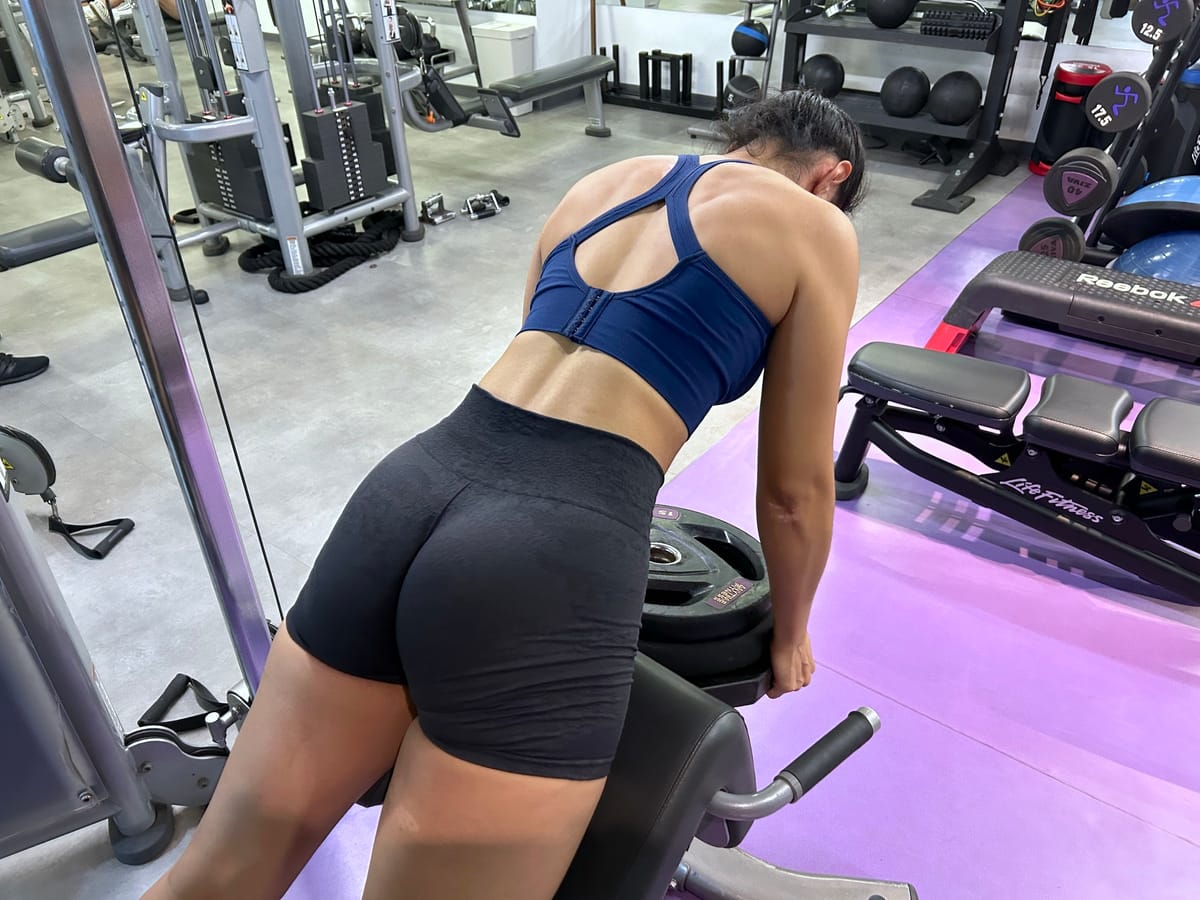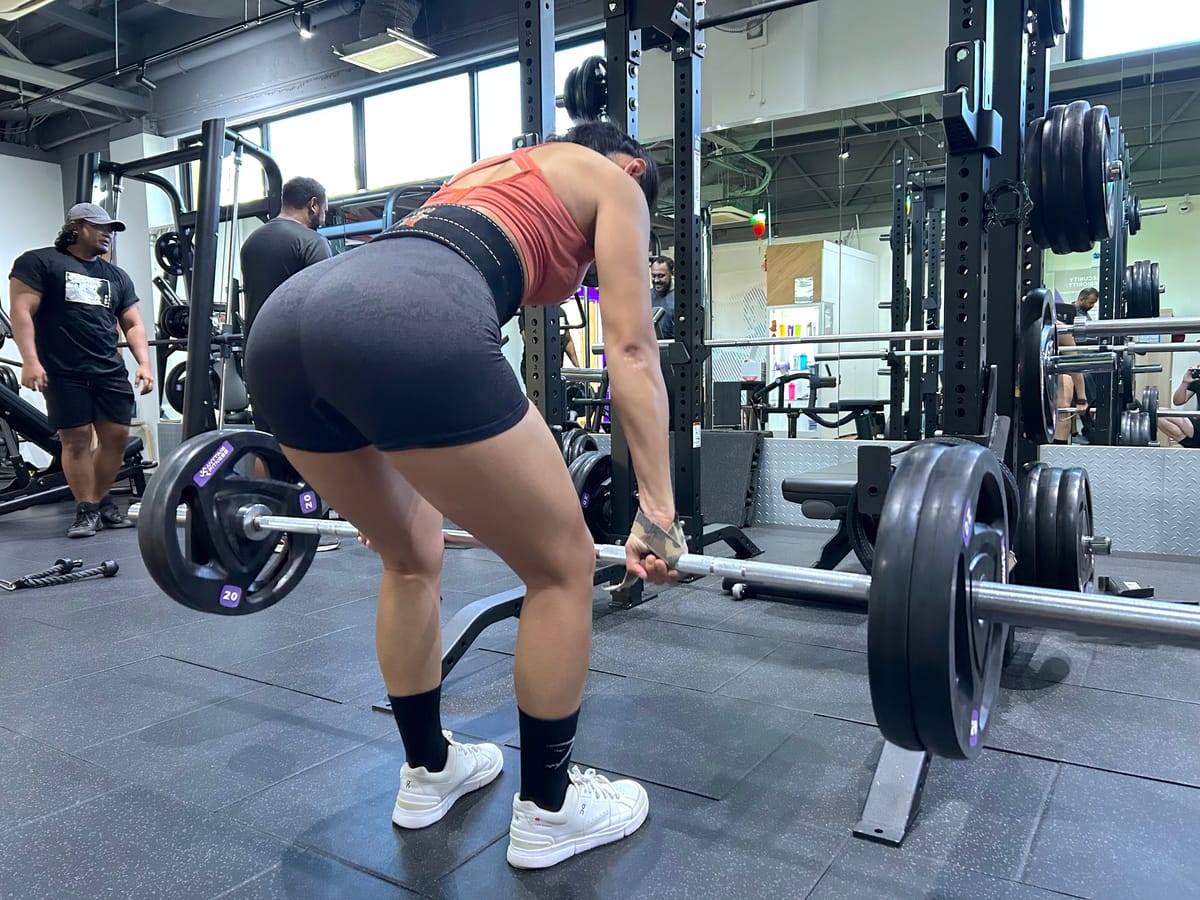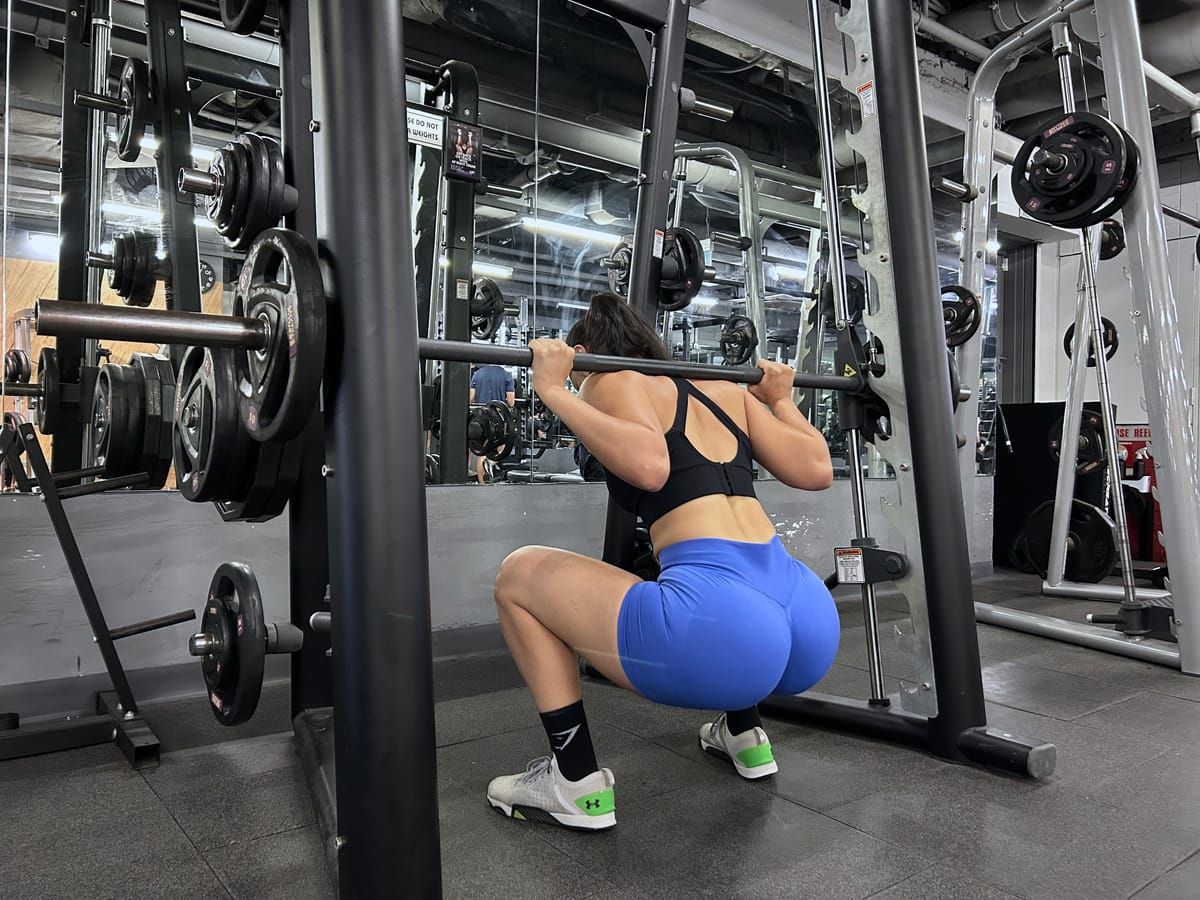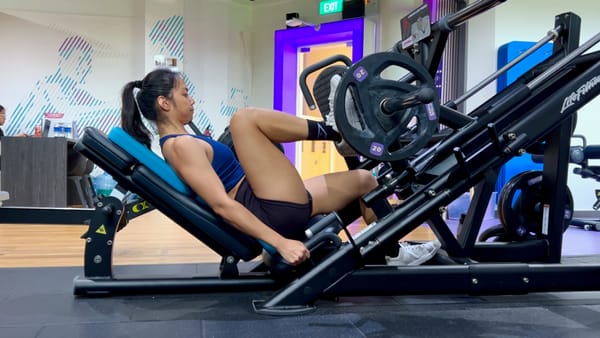7 Barbell Hip Thrust Alternatives to Train Your Glutes
Don't like hip thrusts? Or lazy to set it up? You can still train glutes with these 7 barbell hip thrust alternatives. Machine options included.

Hip thrust alternatives? Why? What even is the point?
Well, for all its merit as one of the best exercises for building big, beautiful glutes, the barbell hip thrust can be disgustingly difficult to set up.
And we’re not even talking about the technical bit — you know, where your shoulder blades should land on the bench or how far your feet should be from the bench — yet.
Just trying to find an available barbell in the gym can feel like The Hunger Games … much less also scoring:
- A bench and
- A non-crusty hip thrust pad and
- Enough space to set everything up
Tragically, as anyone who’s ever stepped into a gym at 7 pm would tell you, the odds are almost never in your favor. Which is why this article exists.
Here are 7 barbell hip thrust alternatives that’ll train your glutes without having to pray for a gym-clearing miracle.
#1: Some kind of squat
Squats? What are squats doing in this list of glute exercises? We’ll tell you.
In this new 2023 (pre-print) study published in bioRxiv, fitness researchers randomly assigned untrained college-aged participants to 2 groups:
- Barbell back squats only
- Hip thrusts only
Other than the difference in glute exercise, the participants underwent an identical strength training program, where they:
- Performed 2 supervised workouts weekly, with
- Training volume equated at 3 to 6 sets, to volitional failure at 8 to 12 reps
There were no significant differences between groups in macronutrient intakes.
Guess what the researchers found after 9 weeks?
The barbell back squat and hip thrust were equally effective builders for the upper, middle, and lower gluteus maximus, as well as total glute size.
And there you have it. This explains squats’ appearance in our list of hip thrust alternatives. Now, of course, you should ideally do barbell back squats.
Here’s the amazing Meg sharing how you could squat with good form:
But if the barbell back squat is impossible because all the squat racks are taken, and by people who obviously look like powerlifters on set 2 out of 100, then any of the following would work fine as an alternative, too.
Goblet squat
If you're relatively new to squats, the goblet squat is a great way to work on your squat fundamentals. It's similar to the front squat, but with lower mobility requirements.
Compared to the back squat, it allows for a more upright torso — a more natural and comfortable position — while targeting your quads more.
The goblet squat is also a helpful exercise for anyone working on your ankle mobility since your knees have more room to move forward.
Here’s how to perform the goblet squat:
Leg press
The leg press is a wonderful machine-based squat exercise.
It offers a very stable setup, which means you can focus on pushing hard with these. This complements your free weight squat options.
Plus, most gyms have one, so you don't have to worry about availability.
Here are some feet positioning options for the leg press:
Hack squat
Lucky enough to have this in your gym? Give the hack squat a shot.
It replicates the squat movement more closely than the leg press.
Of course, this isn't to say it's better than the leg press. It's simply another great option for a squat-based movement.
Here’s an awesome hack squat tutorial by Dr. Mike Israetel:
#2: Bulgarian split squat
OK, so, technically, the BSS, as we so endearingly call it, is also a type of squat.
But we pulled it out because it’s a special type of pain a unilateral exercise that’ll help address any muscle imbalances in your glutes.
Imbalances could be a recipe for injury. Plus, having your right glute look noticeably bigger than the left (or vice versa) when you’re wearing that viral Skims dress is … not a good look. Trust us.
Despite its undemanding nature in terms of space and equipment needed, the BSS can be a tricky exercise to get right because of all the balancing.
To prevent you from hurting yourself by hopping with 20 kg dumbbells in a desperate attempt to find that ✨ perfect ✨ shin angle at the bottom of the exercise … watch this carefully.
How to set up the Bulgarian split squat by Dr. Aaron Horschig:
What if you don’t want to do the BSS? Then try these exercises that are somewhat BSS-adjacent.
Split squat
Still a unilateral movement, but with both feet firmly planted on the floor.
If you're just starting out, go with the split squat. The added stability helps you master the movement before you progress to harder variations.
How to do the split squat:
Reverse lunge
Prefer a more dynamic movement? Try the reverse lunge.
Instead of having both feet in fixed positions, you back foot is now constantly moving.
Of course, you're going to need to focus on balancing more with the reverse lunge.
Here’s how to do the reverse lunge:
@jessicabickling ♬ Solo - Future
#3: Romanian deadlift (RDL)
Just like the squats, the Romanian deadlift (RDL) challenges your glutes the most when they’re stretched — and this, i.e., stretch-mediated hypertrophy, has increasingly been found to be a potent muscle growth stimulus.
Meaning? The RDL also earns a well-deserved mention on our list of hip thrust alternatives.
Now, the RDL can seem like a scary and complicated exercise at first, but rest assured that it’s really not. You just need to keep the following form tips in mind:
- Brace your core and maintain a neutral spine
- Keep your knees slightly bent
- Keep the barbell in contact with your thighs at all times
- Only go as low as your mobility allows (where your butt can’t move back further)
More tips on the RDL (+ other butt-building exercises) here:

Here’s a wonderful RDL demo by Eugene Teo:
Dumbbell RDL
The dumbbell RDL is a wonderful alternative to the barbell version.
Since the dumbbells travel along the sides of your legs, the weight distribution will be closer to your body's "midpoint" than with the barbell RDL. This could make it a more comfortable setup for some.
Heads-up: use lifting straps if you're going heavy. It's going to help a lot, especially with the racking and unracking.
Check out this (insanely heavy) dumbbell RDL:
@anely.kebfit Just casually doing rdls with 100lbs dumbbells 🫦… the gains are coming in hot🫡 #fyp #fitness #gymtok #workoutroutine #rdl #glutesworkout #gym #fittok ♬ original sound - DJ SARDINE
Smith machine RDL
Let's not forget the (often unloved, but available) Smith machine.
Compared to the barbell RDL, this is a more stable setup, so you can go heavier.
Plus, there's a much better chance of getting a Smith machine than a rack.
A great demo of the Smith machine RDL:
@almaalyssarodrigu the booty gains from using smith machine are unmatched 🤌🏼
♬ Helicoptero - El Alfa
Psst, stop missing out on the Smith machine — it's a real beast:

#4: Back extension (45-degree hip extension)
You can think of the back extension as a beginner-friendly alternative to the RDL.
It “locks” you in a set movement pattern, which helps you:
- Familiarize yourself with what it feels like to perform the hip hinge
- Strengthen your glutes
… which are both really transferable to the “big” lifts, including the RDL and the deadlift. Here are a few form tips:
- Point your toes 45 degrees outwards
- Think of thrusting your hips into the pad as you contract your glutes
- Set your pad’s height right under your pubic bone
How to get your back extension (45-degree hip extension) right:
Single-leg back extension
OK, we bet you didn't know this, but the back extension can be done with just one leg.
Just be warned, it's not easy so don't rush into loading it up.
Here's how to do the single-leg back extension:
#5: Glute kickback
The glute kickback is another wonderful unilateral exercise on our list.
There are 2 types of glute kickbacks you could do: cable glute kickbacks and machine glute kickbacks. Regardless of which you do, you’ll want to:
- Brace your core (this prevents you from hyperextending your back)
- Extend your working leg only until you feel a complete glute contraction (i.e., don’t exceed the active range of motion)
Cable glute kickback
This is the version you'd see most often since the setup is pretty straightforward.
Just remember that with the cable glute kickback, you have more flexibility with your kicking direction.
Kicking back sideways emphasizes the gluteus medius and minimus more (compared to the gluteus maximus). This is usually recommended since the gluteus maximus tends to be well taken care of by other glute exercises.
If you prefer to target your gluteus maximus — as the hip thrust does — make sure you kick straight back instead of sideways.
How to set up the cable glute kickback:
@moveswithmaci Cable kickback tutorial 💖@DFYNE dc maci #gymgirl #girlswholift #gymgirls #beginnergymgirl #shygymgirl #glutegrowth #glutesworkout #glutegains #beginnergymtips #gymtips #cablekickbacks #cablekickbacktutorial #gymformtips #gluteworkout #gymformtips ♬ original sound - MACI PARRY | ONLINE COACH
Want more support? Try the bench-supported cable glute kickback:
@sharellegrant Holy glutes!! 🌶️🥵 Have you tried these!? If not, you'll want to save this. #glutesworkout #glutegains #gymgirl ♬ WOTSAPNIN PT. TWO - Blazer Boccle
Machine glute kickback
If you're lucky enough to have this in your gym, this machine is a wonderful option.
It keeps you really stable so you can focus hard on your glutes.
Check out the machine glute kickback:
#6: Kettlebell swing
If you one day find yourself without access to the barbell, dumbbells, or necessary machines (e.g., cable machine, or leg press), there’s always the kettlebell.
While kettlebell swings wouldn’t be your first pick from this list of glute exercises, they’ll work fine in a pinch.
Um. TBVH, we don’t have anything much to say about it so ...
Here's how to do the kettlebell swing:
#7: Step-up
Step-ups may seem simple at first glance, but it’s arguably the most difficult exercise on this list of barbell hip thrust alternatives because of how much it’ll challenge your balance (yes, even more so than the notorious BSS).
Nonetheless, it’s an exercise you shouldn’t pass over because it puts your glutes in a lengthened position.
As mentioned earlier, that’s like high-octane juice for muscle growth. Psst: If you get the Mad Max reference, consider us instant besties.
OK. Back to business. You have a few step-up options.
Dumbbell step-up
This is the simplest setup available. Just grab a dumbbell, kettlebell, or any form of weight really.
Ideally, find something you can hold on to with your free hand. This adds much needed stability to the exercise.
Here’s how to perform the dumbbell step-up so you don’t go viral for a gym accident 🫣:
Smith machine step-up
Don't want to hold on to dumbbells or prefer to work with more weight? The Smith machine step-up is an excellent alternative.
How to do the Smith machine step-up:
Are you missing out on the amazing, but very unloved, Smith machine?:

Cable step-up
Surprise surprise, the step-up can be done on the cable machine too!
Best part of the cable? It offers a difference resistance profile from free weights.
How to perform the cable step-up:
@gluteguy Great way to perform step ups - using a cable column! #fitnesstips #glutesworkout #fyp #foryoupage ♬ original sound - Bret Contreras
Smith machine hip thrust alternatives
Want to build your glute workout around 1 machine? That’s boring, but possible!
Here’s a list of the hip thrust alternatives you can do on the Smith machine:
1. Smith machine squat
2. Smith machine Bulgarian split squat
3. Smith machine reverse lunge
4. Smith machine RDL
5. Smith machine good morning
6. Smith machine glute kickback
7. Smith machine step-up
Some options here have been covered earlier, while others are simply variations of the exercises we’ve mentioned.
Of course, having all these Smith machine options don’t mean you have to use all of them. Instead, give them all a try and pick the exercises you enjoy the most!
You can dive into some tutorials on using the Smith machine here.

Machine hip thrust alternatives
Prefer to build your glute workouts around machines? We got you.
Here’s a list of hip thrust alternatives you can do on machines:
1. Leg press
2. Machine hack squat
3. Machine V squat
4. Machine belt squat
5. Machine glute kickback
6. Shrug machine RDL
Just like with the Smith machine, the exercises you see here are variations of those we’ve mentioned earlier.
These machine hip thrust alternatives complement their free weight counterparts. They provide more stability to the exercise, allowing you to focus on overloading and reducing the level of technique required.
Don’t neglect your gluteus medius and minimus
There’s a common thread running along our list of hip thrust alternatives.
They don’t effectively target the gluteus medius and minimus (butt muscles that wrap around the sides of your upper butt).
If you want round, 3D juicy glutes, you need to hit them.
But how? And with what? Find answers here:

Happy building!






